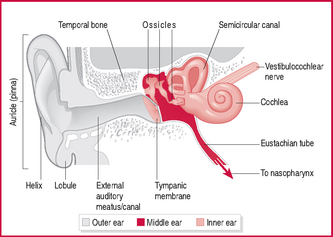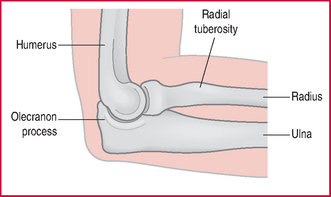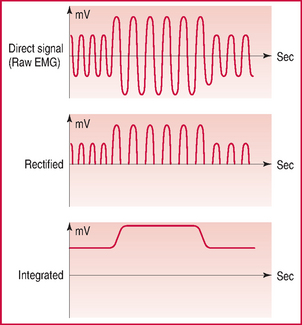E
ear the structures concerned with hearing and also with balance and posture. (1) The external ear leads to the tympanic membrane (eardrum) which separates it from (2) the middle ear, where the chain of ‘ossicles’ transmits sound vibrations to (3) the inner ear containing the sense organs for hearing (the cochlea) and for movements of the head (the vestibular apparatus). Afferents from these pass into the brain in the auditory nerve. The cavity of the middle ear is connected to the pharynx via the Eustachian tube.
ear injury usually refers to injury of the external ear, most commonly seen in contact sports such as rugby (especially in forwards) and boxing, and due to direct trauma. Lacerations and bruising are the most common. See also cauliflower ear.
eating disorders the key functional requirements for the clinical definition of an eating disorder are that the behaviour must no longer be under personal control and/or must cause significant adverse changes in psychological, social or physical functioning. The most severe eating disorders are anorexia nervosa and bulimia nervosa. See also anorexia, bulimia.
eccentric action active resistance by a muscle to lengthening, e.g. that of quadriceps during controlled descent of a hill or stairs. Also referred to, paradoxically and unwisely, as ‘eccentric contraction’ or even ‘lengthening contraction’. Unlike a spring in the equivalent situation, a muscle expends energy even during such passive extension, as both excitation and cross-bridge cycling must continue, although this is a fraction of the energy cost of concentric actions generating the same force at the same absolute velocity. eccentric exercise involves the principal muscles in eccentric action. Because most (though not all) muscles can produce higher forces in this mode of action than in isometric or concentric exercise, greater training effects are widely considered to result, though greater muscle damage and delayed-onset muscle soreness (DOMS) may ensue in unaccustomed subjects. See also force–velocity relationship, muscle contraction, work.
eccentric force a force applied at a distance away from an axis of rotation, therefore a force causing a rotational moment (torque). Applies to all muscle actions at joints, whether the muscle itself is acting eccentrically or concentrically. See also concentric contraction, eccentric action.
echocardiography the use of ultrasound as a diagnostic tool for studying the structure and function of the heart. Used in sport primarily as a screening tool for the potential causes of sudden death. Echocardiography is non-invasive but requires expensive equipment and a trained operator. See also hypertrophic obstructive cardiomyopathy.
efferent ‘going away’. Describes nerves that carry impulses away from the central nervous system, or from relay stations outside it, to effector organs or tissues, e.g. motor nerves to muscle, secretory nerves to glands. Also describes blood or lymph vessels in which flow is away from some point of reference, e.g. efferent arterioles leaving the glomeruli of the kidney; efferent lymph vessels draining lymph glands. Opposite of afferent.
efficiency the ratio of energy (or work) output by a body or device to the energy input required. mechanical efficiency the ratio of mechanical energy output (or work output) to the energy input.
effusion extravasation of fluid into body tissues or cavities, such as a pleural effusion, or into joints where it causes swelling. In sport a joint effusion is a sign of significant damage to the joint. A knee filled with blood, rather than with joint (synovial) fluid, is called a haemarthrosis, an injury requiring immediate care (e.g. cruciate ligament damage in the knee).
ego involvement a state in which the individual’s goal is to demonstrate ability relative to that of others. ego-involvedadj. See also task involvement, performance goal.
ego orientation a dispositional tendency to feel most successful in an activity only when one demonstrates one’s ability relative to that of others, such as when one outperforms an opponent. See also achievement goal orientation, task orientation.
elastic potential energy the energy due to changes in the distance between molecules of a body or object, usually when it is compressed (e.g. a spring) or stretched (e.g. an elastic band). In animal (human) movement, important sources of such energy are muscles and tendons.
elasticity the ability of a material to be compressed or stretched, and to return to its original state.
elastin see connective tissues.
elbow joint ‘hinge joint’, allowing only flexion and extension, between the lower end of the humerus and the upper ends of the ulna and radius. The prominent medial and lateral epicondyles of the humerus provide attachment for the major ligaments on the two sides of the joint: on the inside to the margin of the concave notch on the ulna, and on the outside to the ligament around the head of the radius. elbow injury see tennis elbow, golfer’s elbow; appendix 1.2.
electrocardiogram (ECG) a recording of the electrical activity of the heart muscle during the cardiac cycle, as transmitted to electrodes placed at specific sites on the chest. The normal heart produces a waveform which consists of five deflections known as PQRST, relating to consecutive events in the atria and ventricles. ambulatory ECG (Holter monitoring) recording over 24 h to detect any transient ischaemia or arrhythmias; the person continues with their normal activities, keeping a record of their time and nature. exercise (stress) ECG may be performed during increasing levels of exertion, such as on a treadmill, to detect any abnormalities caused by physical stress. Used for the diagnosis or prognosis of heart disease or to monitor cardiac rehabilitation. In sport, used primarily as a simple and inexpensive screening tool for potential causes of sudden death; ECG is recorded continuously during treadmill and cycle ergometer fitness testing.
electrogoniometer a device for measuring angles (usually joint angles) directly, giving an electrical output (often interfaced to a computer). electrogoniometry the use of this device.
electrolyte balance the state of appropriate concentrations of ionized solutes in the body fluids. Exercise-induced disturbances in electrolyte balance are mainly related to either increase or decrease in concentration of sodium [Na+], the most abundant cation in the extracellular fluids. Increase in plasma [Na+] (hypernatraemia) is associated with depletion of blood volume by severe sweat loss and is common in athletes at the end of long-distance races. Exercise-associated decrease in plasma [Na+] (hyponatraemia) is not uncommonly seen after prolonged activity such as a marathon where runners, aware of the importance of adequate fluid intake and rehydration, overcompensate with low-sodium drinks or excessive plain water (water intoxication). This can result in significant hyponatraemia, leading at worst to cardiovascular collapse and death. See also hydration status, potassium, sodium, sports drinks.
electrolytes substances in solution in the ionized state, carrying an electrical charge (anions negative, cations positive). Applies to those in the body fluids, where dissociated sodium chloride is the major electrolyte in extracellular fluids (Na+and Cl−), and potassium (K+), with organic anions, in intracellular fluids. Other physiologically important cations are calcium and magnesium, and the anions bicarbonate and phosphate. Normal electrolyte concentrations are essential for normal cellular function. Movements of ions are crucial in the maintenance of potential differences across cell membranes and, for example, in the generation and transmission of nervous impulses, neuromuscular and synaptic transmission, and all secretory function. See also minerals; appendix 4.3.
electromyography (EMG) technique of recording electrical activity of muscle either percutaneously, with adhesive pad electrodes (more common but can only be applied to superficial muscles), or intramuscularly, through fine wires, usually of platinum, insulated except at their tips (records from a smaller domain within a muscle, but not necessarily a superficial one). EMG is used in both normal and pathophysiology to study the timing of muscle activation, as well as its extent, to which the resultant force generation is approximately proportionate. electromyogram the trace that is recorded. integrated EMG electronically processed modification of the direct signal from the electrodes. As muscle action potentials pass under the electrodes they will each go positive and negative by turns, making a ‘biphasic’ (AC) signal; to integrate this, the signal is first rectified and then smoothed with a time constant such that the trace produced looks similar in form to a mechanical record of the resulting contraction.
< div class='tao-gold-member'>











